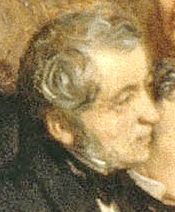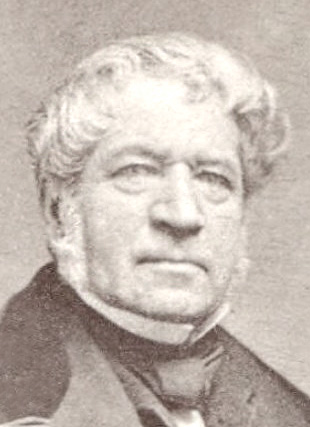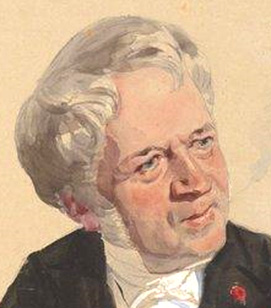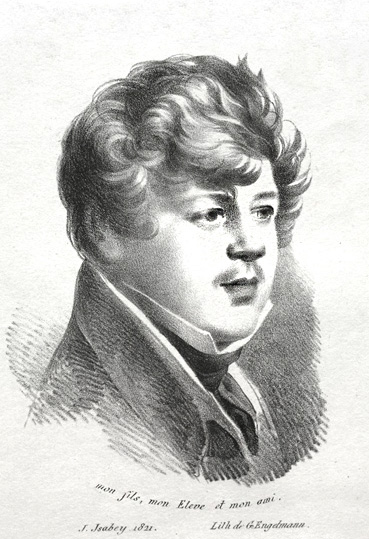Eugène Isabey (1803 - 1886), marine and landscape painter
1st image: Soirée; 2nd: photo Nadar (1860); 3rd: photo Receuil. Celebr. (c.1860); 4th:caricature by Giraud (1868); 5th: by Jean Isabey (1821); Video Youtube.
Louis Gabriel Eugène Isabey, son of the miniaturist and lithographer Jean-Baptiste Isabey52, appears in the caricature by Giraud11 with an excellent likeness that corresponds to this person represented in Une Soirée. A family drawing of 1821 by his father, titled “my son, my student, my friend,” already records Eugène’s thick curly hair in youth.
Isabey’s prominence on the Parisian art scene from the 1830s and his wide aristocratic connections make it likely that he was among those who held a standing invitation to de Nieuwerkerke’s vendredi-soirées. Horace de Viel-Castel43 records the presence of Jean Isabey, then eighty-seven, at the Friday of 7 November 1852, and Eugène customarily accompanied his father on such occasions. Earlier that year both father and son, together with numerous figures depicted in Une Soirée (for example Auber56, Augier53, Delacroix10, Halévy19, Muller18, Mérimée54, de Nieuwerkerke16, Viollet-le-Duc40a), attended the dinner at which de Morny48 announced his resignation as Minister of Interior affairs. In the same year Isabey was made an Officer of the Légion d’honneur and donated a family portrait by Gérard to the Louvre, events that plausibly explain his appearance at several vendredi-soirées. Giraud’s caricature of Isabey dates from an après-soirée many years later, 13 March 1868.
For decades Jean Isabey’s house served as a gathering place for artists. His father’s intimacy with both the Bonaparte circle and the royal court brought the sociable young Eugène into elite networks at an early age. Although trained in drawing and engraving by his father and through studies at the Louvre, the young Isabey initially showed only moderate interest in a conventional atelier career. He enjoyed rowing, learned to sail, and at one point aspired to become a sailor or other naval profession. A visit with his father to Le Havre exposed him to the effects of light on sea and shore; he began making coastal sketches and watercolours that reconciled his maritime interests with his artistic training, and his father’s wishes. Family connections enabled him to exhibit at the Salon in 1824, where he won a first-class medal in marine painting.
Isabey befriended Eugène Delacroix and the English-born Richard Parkes Bonington and travelled with them to England in 1825 to study William Turner and other English watercolourists. Whereas Delacroix assimilated the English painters’ grand manner, Isabey focused on their fine detail and topographical accuracy.
Isabey’s extensive social network secured him a broad clientele and steady commissions, especially for marine subjects. His landscapes and highly detailed interior studies were prized by private collectors. Viel-Castel complains in his memoirs about the large commissions, one reported at 6,000 francs, awarded to Isabey by de Nieuwerkerke, a sum that provoked his criticism of Louvre expenditure. However, we should consider that some of Isabey’s paintings were monumental, occasionally reaching three metres in height and width. His depiction of the naval combat on Lake Erie (1840) was so large that he collaborated with his pupil and friend Morel-Fatio63; the work bears both signatures. Unfortunately, its present location is unknown.
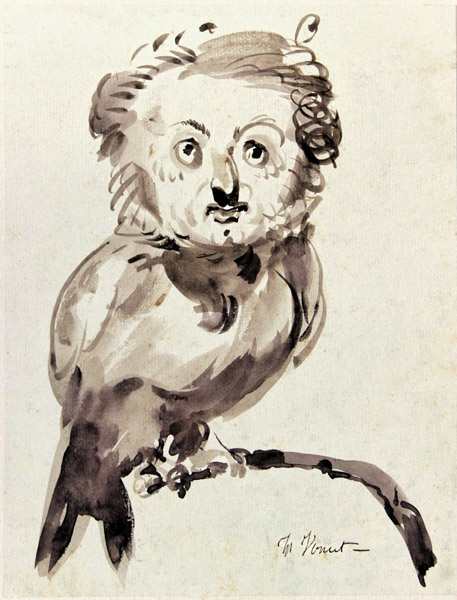
by Vernet c. 1825)
Both Isabey and Morel-Fatio practised sketching from rowing boats around Paris, making frequent stops to draw en plein air, a marked departure from atelier-only production. Isabey became an accomplished oarsman and was locally nicknamed “admiral of the lake” at Enghien. His cottage on the lake adjoined that of Frédéric de Reiset65, Louvre conservator and mayor of Enghien-les-Bains; Princess Mathilde and de Nieuwerkerke resided a short distance away at Saint-Gratien. Isabey and de Nieuwerkerke regularly sailed or rowed together.
Horace Vernet31, whose studio was nearby, caricatured Isabey as an owl perched on a branch after noting that the painter’s cottage stood above ground on four large poplar beams at the edge of the lake; that caricature later entered the collection of the conservator de Chennevières20. Vernet, Isabey, and Morel-Fatio were among the founders of the Le Havre Regatta Society in 1839.
Often described as the “Horace Vernet of marine painting,” Isabey’s work also forms a link between neoclassical academicism (for example Ingres39) and the approaches that anticipated impressionism. Although Isabey practised plein-air sketching, the later technical innovation of paint in tin tubes (invented in 1841 by American John Rand, living in England) helped make on-site oil painting more practicable for the Impressionists.
Contemporary juries and government patronage continued to favour Romantic and academic painting, however. In 1863 Isabey joined some 180 painters, including Delacroix and Camille Corot, in an appeal to de Nieuwerkerke to admit more contemporary works to the Salon; the petition sought rapid reconsideration of the jury’s refusal of over six thousand works, and prompted Napoleon III to allocate additional exhibition space in the Palais de l’Industrie. This episode contributed to what is known as the Salon des Refusés.
Although famous for his marine paintings, Isabey also excelled in interiors and landscapes; his drawings and watercolours remain sought after by collectors.
See above video link for examples of his work.
